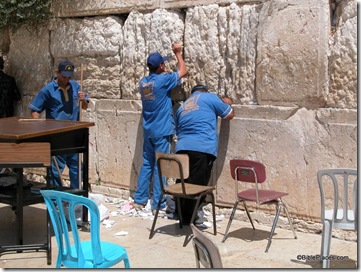One of the Most Spectacular Mosaic Floors Ever Discovered in Israel was Restored and Renovated and Can Now be Seen by the General Public (30/3/09)
The 1,500 year old (!) mosaic is in the ancient synagogue at Ma‘on-Nirim The mosaic, which is decorated with a seven-branched candelabrum and images of different animals, was conserved and returned to its original location. The site is now open to the general public and admission to it is free.
The site of the mosaic floor, which is part of a synagogue from the Byzantine period (fifth and sixth centuries CE), is located in the settlement of Ma‘on-Nirim, in the western Negev, and will be open to the public this week. This mosaic originally measured 3.70 x 7.80 m but was damaged when the road to Kibbutz Nir Oz was paved in 1957. The mosaic floor and the remains of the synagogue were discovered during salvage excavations that were undertaken on behalf of the Department of Antiquities in 1957. The mosaic’s state of preservation has deteriorated in recent years as a result of the unsuitable conditions in which the mosaic was kept and a lack of maintenance. Therefore, in 2006, it was removed from the site and transferred for treatment to the Conservation Laboratories in the Rockefeller Museum in Jerusalem….
According to the archaeological findings the northern wall of the synagogue’s sanctuary was breached in the middle of the sixth century CE and an apse, which is a circular niche that protrudes outward, was installed in the opening. The level of the earlier floor was raised and a breathtakingly beautiful mosaic floor surrounded by marble columns was constructed on top of it in the northern part of the sanctuary. The synagogue had a basilica plan in which there was a nave with a mosaic floor that was flanked by two aisles paved with stone tiles. The ceiling was built of wooden beams and clay. The decoration on the mosaic floor consists of a vine tendril that stems from an amphora to form a trellis of medallions that are adorned with scenes of everyday life from the vineyard and from wine production and with different animals. The images portrayed in the upper rows include a seven-branched candelabrum that stands on three legs shaped like lion’s feet, and near them etrogim, a shofar and a lulav, and alongside the candelabrum – palm trees and lions, which are symbols of Judah. An Aramaic inscription is incorporated in the mosaic. The upper part of the inscription blesses all of the community followed by a dedication to three individuals who donated generous contributions.
